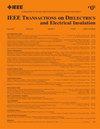The Distribution and Erosion Characteristics of Plasma Particles in Magnetron Sputtering Under Different Excitation Voltage Sources
IF 3.1
3区 工程技术
Q2 ENGINEERING, ELECTRICAL & ELECTRONIC
IEEE Transactions on Dielectrics and Electrical Insulation
Pub Date : 2025-07-16
DOI:10.1109/TDEI.2025.3589978
引用次数: 0
Abstract
Magnetron sputtering is widely used in thin film fabrication and surface modification of materials. During the sputtering process, the spatial species distribution significantly impacts the deposited film’s properties. However, there are still some difficulties in understanding the spatial species distribution, transport and energy control, resulting in uneven coating and low target utilization. In this article, we utilized a 2-D magnetron sputtering plasma model to further investigate the species distribution of the plasma under different excitation voltage sources and consequently obtain the Ar+ sputtering energy distribution. The erosion phenomenon was studied in the transport of ions in matter (TRIM) software, and the particle energy and angle obtained from the plasma simulation were used as input to study the incident distribution and sputtering yield. The results show significant differences in the distribution, density, and sputtering energy of plasma under dc, radio frequency (RF) (13.56 MHz) and high-power pulse (HPP) excitation voltage sources. Under dc, the electron distribution is more uniform than other excitation sources, covering 40%–50% of the target surface area. The initial sputtering energy distribution ranges from 0 to 400 eV with an erosion depth of 20Å, and the sputtering yield is approximately proportional to the voltage. The sputtering yield increases slower under RF when the voltage reaches 1000 V. Under RF, the electric field distribution is uniform at 800 V, but Ar+ is concentrated covering only 15% of the target surface. Under HPP, the electron and Ar+ densities reach磁控溅射中不同激励电压源下等离子体粒子的分布及腐蚀特性
磁控溅射广泛应用于薄膜制备和材料表面改性。溅射过程中,溅射物的空间分布对溅射膜的性能有显著影响。然而,在认识物种的空间分布、迁移和能量控制方面仍存在一些困难,导致涂层不均匀,目标利用率低。本文利用二维磁控溅射等离子体模型,进一步研究了不同激励电压源下等离子体的物质分布,从而得到了Ar+溅射能量分布。在离子在物质输运(TRIM)软件中研究了腐蚀现象,并将等离子体模拟得到的粒子能量和角度作为输入,研究了入射分布和溅射成品率。结果表明,在直流、射频(RF) (13.56 MHz)和大功率脉冲(HPP)激励电压源下,等离子体的分布、密度和溅射能量存在显著差异。在直流激励下,电子分布比其他激励源更均匀,覆盖目标表面积的40%-50%。初始溅射能量分布范围为0 ~ 400 eV,腐蚀深度为20Å,溅射成品率与电压近似成正比。在射频下,当电压达到1000 V时,溅射成品率的增加速度较慢。在RF作用下,800 V时电场分布均匀,但Ar+仅集中覆盖目标表面的15%。在HPP下,电子和Ar+密度达到$10^{{17}}$ - $10^{{18}}$ m ${}^{-{3}}$,最高电子电流密度达到$5\乘以10^{{3}}$ A/m2。溅射深度为30Å。该研究对优化磁控溅射工艺参数,提高薄膜性能具有重要意义。为磁控溅射工艺的发展和应用提供了有力的支持。
本文章由计算机程序翻译,如有差异,请以英文原文为准。
求助全文
约1分钟内获得全文
求助全文
来源期刊
CiteScore
6.00
自引率
22.60%
发文量
309
审稿时长
5.2 months
期刊介绍:
Topics that are concerned with dielectric phenomena and measurements, with development and characterization of gaseous, vacuum, liquid and solid electrical insulating materials and systems; and with utilization of these materials in circuits and systems under condition of use.

 求助内容:
求助内容: 应助结果提醒方式:
应助结果提醒方式:


